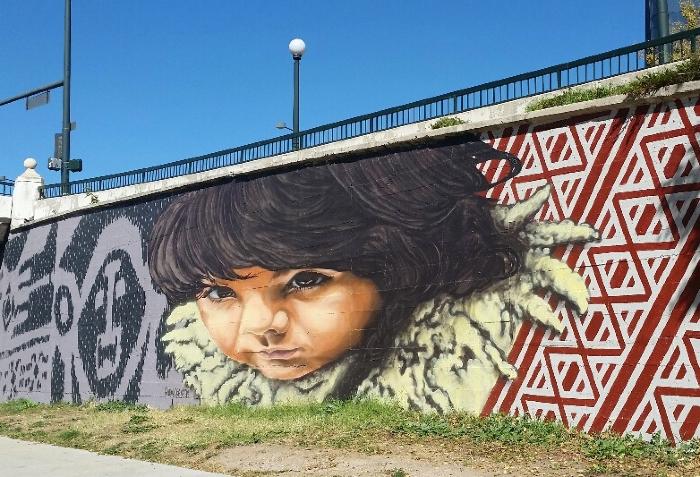Paramount
Urban Arts Fund
UAF.2016.4
* No Longer on View *
The "Paramount" murals on Cherry Creek revisit the history of humanity in America and its relationship with nature. For the two murals framing both sides of the Broadway bridge, Alexander Orion, an internationally recognized artist from Brazil, used a forced perspective technique that distorts paintwork to create an optical illusion when viewed diagonally from the bicycle trail.
A child surrounded by Native American patterns is shown on either side of the bridge, relating the artwork directly to the river and its banks, in order to revisit humanity’s relationship with nature. Orion chose these walls for his murals because they stake out a natural boundary between the creek and a city produced by a civilizing process. "The river environment was a great source of inspiration," he says. "The history of this place comes from this river where native peoples came together or traveled. Settlers arrived here; battles were fought here; people lived and died here. It is the origin of everything. The city arose from this place and now the river is an oasis hemmed in by asphalt and high walls securing the city."
Having worked on walls around the world for more than 22 years, Orion was struck by the peace and quiet of Cherry Creek, hence his decision to highlight the paradox between walls and river, and between nature itself and the landscape controlled by civilizing forces. Feeling that “we are losing touch with Earth, our origin,” he decided to revisit aspects he sees as paramount. “Painting children harkens back to the earliest periods of humanity’s existence. Native Americans were the first inhabitants of this land. We are all part of this civilization and we all contribute to what we call evolution, but to find a truly evolutionary path, I believe we must revisit our history to redeem ourselves from the barbaric crimes that were committed against Nature and human beings. We must recognize ourselves in our relationship with Nature.”
The "Paramount" murals on Cherry Creek revisit the history of humanity in America and its relationship with nature. For the two murals framing both sides of the Broadway bridge, Alexander Orion, an internationally recognized artist from Brazil, used a forced perspective technique that distorts paintwork to create an optical illusion when viewed diagonally from the bicycle trail.
A child surrounded by Native American patterns is shown on either side of the bridge, relating the artwork directly to the river and its banks, in order to revisit humanity’s relationship with nature. Orion chose these walls for his murals because they stake out a natural boundary between the creek and a city produced by a civilizing process. "The river environment was a great source of inspiration," he says. "The history of this place comes from this river where native peoples came together or traveled. Settlers arrived here; battles were fought here; people lived and died here. It is the origin of everything. The city arose from this place and now the river is an oasis hemmed in by asphalt and high walls securing the city."
Having worked on walls around the world for more than 22 years, Orion was struck by the peace and quiet of Cherry Creek, hence his decision to highlight the paradox between walls and river, and between nature itself and the landscape controlled by civilizing forces. Feeling that “we are losing touch with Earth, our origin,” he decided to revisit aspects he sees as paramount. “Painting children harkens back to the earliest periods of humanity’s existence. Native Americans were the first inhabitants of this land. We are all part of this civilization and we all contribute to what we call evolution, but to find a truly evolutionary path, I believe we must revisit our history to redeem ourselves from the barbaric crimes that were committed against Nature and human beings. We must recognize ourselves in our relationship with Nature.”
